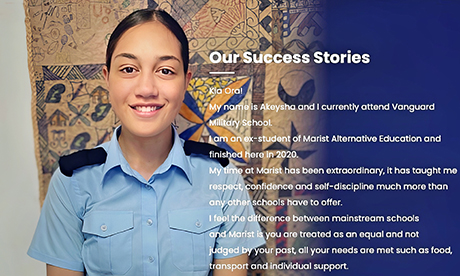The Education Review Office (ERO) has slammed alternative education for at-risk teens. The programme is underfunded and under-performs, it says.
It wants the system overhauled and additional funding provided.
Responding to the need for extra funding, Alan Blackie, chair of the Marist Alternative Education Centre in Glenfield, said additional funding would be very welcome.
“Only 60% of the Marist Alternative Education Centre’s funding comes from Government; the rest the Board has to fund-raise for,” Blackie told CathNews.
The Marist Alternative Education Centre is one of many alternative education centres around New Zealand.
Blackie said that about 25 years ago, the Marist Brothers established the school for students in danger of being suspended.
“Unfortunately, the need hasn’t gone away; rather, it has increased,” he said.
Blackie told CathNews that he admired those involved in alternative education.
“For many reasons, our students are less equipped to learn in a traditional school setting.”
He says the school works around showing respect.
“The school staff work hard to show respect to students and, in turn, looks to the students to mirror that respect to themselves and others.”
A realist, Blackie told CathNews the school has “some wins”.
Acknowledging it is tough work, he says the school is very pleased that it has a registered teacher and is well supported by teaching assistants, all with university degrees in Science and Fine Arts.
Education Review Office report
In a report released this week, ERO says few of the at-risk over 2000 13- to 16-year-olds enrolled in the programme achieved NCEA Level 2.
“Too many ended up on benefits later in life,” ERO says.
“Alternative Education is potentially a missed opportunity to change these young people’s life trajectories.
“They are often engaged and attending, but the current model of provision is failing to provide them with a quality education and may be contributing to poorer outcomes.
“The long-term costs for the young person, their family and broader society are very significant.”
This year’s additional Budget provision equated to only $16,536 per student – less than the funding provided per student in some small secondary schools.
Having to fund-raise to make ends meet does mean some schools have closed through insufficient funding.
Providers offer small-group learning with individual tutors, which students enjoy, but ERO found the results aren’t good.
“The current model of Alternative Education is inadequate … leading to worse outcomes than for other young people,” the report says.
“Teaching is weak and teaching resources are inadequate. Only one in five educators … are registered teachers.
“Facilities are often so run down they act as a barrier to learning. We visited 22 … sites and found six operating out of poor-quality.”
ERO recommends
The report recommends the Education Ministry (MoE) help schools identify and support those most at risk of disengaging from school and provide effective options for pupils who aren’t thriving.
It also recommends overhauling alternative education to provide “a clear national model with standards for high-quality provision and funding”.
It must be enough to meet students’ complex needs.
Alternative education should be based on a national evidence-based teaching model. Registered teachers should be engaged. Small classes and kaupapa Māori approaches should be offered.
The MoE should ensure suitable facilities are provided.
Some of ERO’s statistics
- 76 percent of students preferred alternative education to their previous school
- in the year before beginning alternative education, students miss about 58 days of school
- 68 percent are Māori
- 63 percent are male
- only 9 percent achieved NCEA Level 2 compared to 32 percent of students from comparable backgrounds not in alternative education
- by age 24, 63 percent were on benefits compared to 51 percent for the comparator group
- students are generally exposed to a wide range of negative social environments
- students may be in alternative education from several weeks to several years
Source
- RNZ
- Supplied: Marist Alternative Education Centre in Glenfield.
News category: New Zealand.




